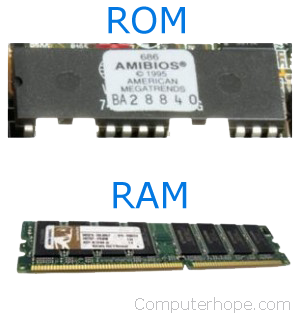What is the difference between ROM and RAM?

There are several major differences between a ROM (read-only memory) chip and a RAM (random-access memory) chip. The differences revolve around how they're used, storage capabilities and capacity, and physical sizes of ROM and RAM chips.
Select a link below for details of the differences and additional information about ROM and RAM.
Table of differences
| Topic | ROM | RAM |
|---|---|---|
| Storage capabilities | ROM is non-volatile, not requiring power to store data. | RAM is volatile, requiring power to store data. |
| Uses | ROM stores the BIOS (basic input/output system) program on a computer motherboard. ROM was used as the storage media in a Nintendo, Gameboy, and Sega Genesis game cartridge. | RAM is used in computers to temporarily store files in use on the computer. |
| Storage capacity | ROM chips often have a storage capacity of 4 to 8 MB. | RAM chips often range in storage capacity from 1 to 256 GB. |
| Physical size | ROM can vary in size from less than an inch in length to multiple inches in length and width, depending on their use. | RAM is available in two primary sizes, whether used in a desktop computer or a laptop. Desktop RAM is about 5 ½ inches in length and 1 inch in width. Laptop RAM is about half the length of desktop RAM. |
Further explanation of differences
Storage capabilities of ROM and RAM
A ROM chip is a non-volatile storage medium, which means it does not require a constant source of power to retain the information stored on it. By contrast, a RAM chip is volatile, which means it loses any information it is holding when the power is turned off. Essentially, ROM is used for permanent storage, and RAM is for temporary storage.
Uses of ROM and RAM
A ROM chip is used primarily in the startup process of a computer, whereas a RAM chip is used in the normal operations after the operating system is loaded. For example, a ROM chip is stores the BIOS program on the motherboard. A RAM chip temporarily stores files in use on a computer, like a document you're writing, an image you're editing, or data for a game you're playing.
Storage capacity of ROM and RAM
A ROM chip stores several MB (megabytes) of data, usually 4 to 8 MB per chip, whereas a RAM chip can store multiple GB (gigabytes) of data, ranging from 1 to 256 GB per chip.
Computer ROM
An example of ROM is the computer BIOS, a PROM (programmable read-only memory) chip that stores the programming needed to begin the initial computer startup process. Using a non-volatile storage medium is the only way to begin this process for computers and other devices. ROM chips were also used in gaming system cartridges, like the original Nintendo, Gameboy, Sega Genesis, and others.

The oldest ROM-type storage medium can be dated back to 1932 with drum memory. ROM-type storage is still used today.
Computer RAM
RAM chips are used in computers and other devices to store temporary information produced by programs quickly. RAM is one of the fastest types of memory, allowing it to switch quickly between tasks. For example, the Internet browser you are using to read this page is loaded into RAM and is running from it.

